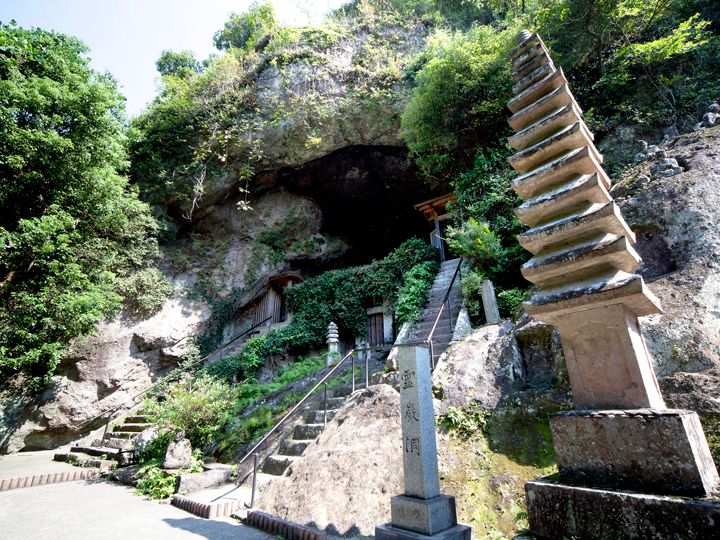Reigando

Statue of disciples of Buddha, "Gohyaku rakan"
On the rock wall from Uganzenji temple to Raigando, the statues of "Gohyaku rakan" are enshrined, made by merchants of Kumamoto about 200 years ago. They make the place looks spiritual. "Rakan" means disciples of Buddha. Each statue is different and has different expressions on their face.

Miyamoto Musashi
Miyamoto Musashi (1584-) was a master swordsman and a military strategist in 1600s. In fact, he is the first one who fought using two swords. He has also created ink paintings and craft works that are chosen as important cultural property. According to "Gorin-no-sho", he has never lost a serious fight in his sixty-something fights. He started to write "Gorin-no-sho" at the age of 60. After two years of writing, he has put down his pen and died two months after that.

(Source: wikimedia)
"Gorin-sho" written by Miyamono Musashi
As you go through a small and steep up and down path, deeper behind the temple, you will reach "Reigando" where stones are piled up at the entrance. After you climb the stairs, you will reach a quiet area in the cave, where a temple with wooden floor lies. There is a statue of Goddess of Mercy, "Iwato Kannon" is enshrined. This place will move you, just thinking how Musashi has stayed here to write in his late years.
"Treasure museum" where you can see documents of Musashi and other poets of Kumamoto
On the right hand side of Hondo Hall, there is a Treasure museum near the entrance of Raigando. Here paintings of Musashi and a wooden sword, "Ganryujima", that he used in the historic fight, are exhibited. There is also a painting of the father of a writer, Seisho Nagon (approx. 966-1025), having a relationship with female poet from Kumamoto, called "Higaki".
Statue of disciples of Buddha, "Gohyaku rakan"
On the rock wall from Uganzenji temple to Raigando, the statues of "Gohyaku rakan" are enshrined, made by merchants of Kumamoto about 200 years ago. They make the place looks spiritual. "Rakan" means disciples of Buddha. Each statue is different and has different expressions on their face.

Miyamoto Musashi
Miyamoto Musashi (1584-) was a master swordsman and a military strategist in 1600s. In fact, he is the first one who fought using two swords. He has also created ink paintings and craft works that are chosen as important cultural property. According to "Gorin-no-sho", he has never lost a serious fight in his sixty-something fights. He started to write "Gorin-no-sho" at the age of 60. After two years of writing, he has put down his pen and died two months after that.

(Source: wikimedia)
"Gorin-sho" written by Miyamono Musashi
As you go through a small and steep up and down path, deeper behind the temple, you will reach "Reigando" where stones are piled up at the entrance. After you climb the stairs, you will reach a quiet area in the cave, where a temple with wooden floor lies. There is a statue of Goddess of Mercy, "Iwato Kannon" is enshrined. This place will move you, just thinking how Musashi has stayed here to write in his late years.
"Treasure museum" where you can see documents of Musashi and other poets of Kumamoto
On the right hand side of Hondo Hall, there is a Treasure museum near the entrance of Raigando. Here paintings of Musashi and a wooden sword, "Ganryujima", that he used in the historic fight, are exhibited. There is also a painting of the father of a writer, Seisho Nagon (approx. 966-1025), having a relationship with female poet from Kumamoto, called "Higaki".





